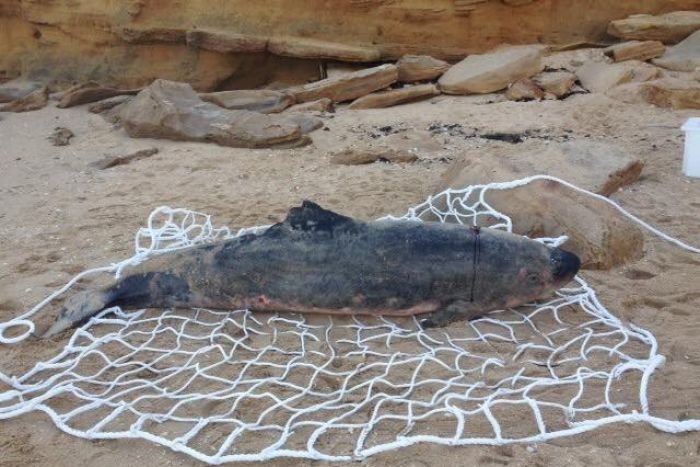
The 2.4-metre long adult female whale died while stranded at Red Bluff on Saturday.
The dwarf sperm whale is a small robust whale with a distinctive underslung jaw, not unlike a shark.
The species is so unique it has never been officially recorded in Victoria.
Stranded whales have previously been found in Western Australia, South Australia, Tasmania, New South Wales and the Northern Territory.
A live sighting of a dwarf sperm whale was confirmed in South Australia in 2006.
Victorian environment department fire crews working on fuel reduction burns in the area were called in to help carry the dead whale from the beach.
Department of Environment, Land, Water and Planning biodiversity officer Tony Mitchell said measurements so far suggested the whale was a dwarf sperm whale.
"It's leading us towards a dwarf sperm whale rather than the more commonly encountered dwarf pygmy whale," he said.
"But we'll get confirmation of that as we go with the genetics or the scalp."
Fire burning crews help out with retrieval
Mr Mitchell said the Department had wildlife personnel at the beach to conduct a post-mortem.
"We required some manpower to move the animal from the beach to the trailer for transport," he said.
"We had burning crews out on Saturday, and we were able to direct crews for Bairnsdale and Nowa Nowa to the beach to provide that manpower."
Mr Mitchell said he was unsure exactly how much the whale weighed, but estimated it was in "the range of a couple of hundred kilograms".
"They'd been burning off all day and it was just a little task tacked on to the end of their day," he said of carrying the whale.
"[Dwarf sperm whales] are closely related to sperm whales, but they are uniquely different; you can't really mistake them."
The dwarf sperm whale is the smallest of the whales, and is even smaller than some dolphins.
Museum to conduct further testing
Scientists at Melbourne Museum will take the whale for their collection and conduct further testing.
Dr Kevin Rowe, senior curator of mammals at Museum Victoria, said they were yet to receive the specimen, but had seen photographs.
He said once the whale arrived, they would try and confirm its species and determine if it was a dwarf sperm whale, or the more common, pygmy sperm whale.
"Stranded [whales] are the primary way we understand either of these two species. These are distant relatives of the sperm whale but they are much smaller," he said.
"They feed off continental shelves in deep water and are rarely sighted at sea...but they do strand occasionally."
Dr Rowe said whales end up stranded on beaches for many reasons, including being outside their range.
However, he said both the dwarf sperm whale and pygmy sperm whale could be found off the southern coast of Australia.
"There's global distribution, everywhere from the United States to Australia," he said.
Second small whale found, link to be investigated
Dr Rowe said there were small differences between the dwarf and pygmy sperm whales.
"The dorsal fin is slightly more erect and curved on a dwarf sperm whale, and it's smaller than a pygmy," he explained.
A second small whale was found stranded at Wonthaggi, also in Gippsland in eastern Victoria on Monday.
Museum Victoria will investigate if there is any link between the two beached whales.
"They can be running out of food, starving, confused, changes in weather, currents can wash them in too close to shore," Dr Rowe said.
"Once they're on the beach, they have a very low chance of surviving."



Reader Comments
to our Newsletter